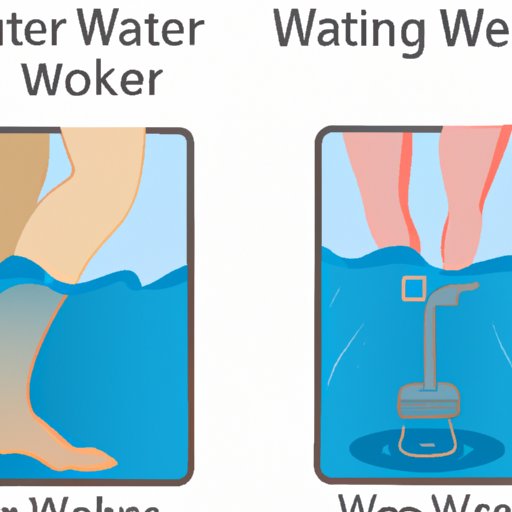
Introduction
Have you ever felt like you’ve gained weight overnight, despite sticking to your healthy eating plan? It’s possible that you are experiencing water weight. Water weight, also known as water retention, is a common cause of weight fluctuations and bloating. Understanding what water weight looks like on your body and how to manage it can help you maintain a healthy weight and feel more comfortable in your own skin.
The Science Behind Water Weight: How It Shows on Your Body
Water weight is the accumulation of excess fluid in your body’s tissues. This can be caused by a variety of factors, including hormonal changes, high salt intake, and dehydration. When your body senses that it is lacking water, it begins to store more water in the tissues to prevent dehydration. This leads to a bloated, puffy appearance on the surface of the skin.
The body stores water in the spaces between cells and in the bloodstream. Hormones like estrogen and cortisol can also influence how much water the body retains. This is why women tend to retain more water than men, particularly during their menstrual cycle or pregnancy. Other factors that influence water retention include high sodium intake, certain medications, and underlying health conditions.
Unveiling the Effects of Water Weight on Your Body’s Appearance
Water weight can affect your body’s appearance in several ways. Firstly, it can cause bloating and swelling in various parts of the body. This can be particularly noticeable around the abdomen, legs, and arms. Water weight can also make cellulite appear more prominent, as it causes the skin to become stretched and waterlogged.
On top of this, water weight can lead to an overall feeling of discomfort and sluggishness, affecting your energy levels and mood. It’s common to experience fatigue, irritability, and brain fog when dealing with water retention.
A Beginner’s Guide to Identifying Water Weight and Its Symptoms on Your Body
Identifying water weight can be tricky, but there are several signs and symptoms to look out for. One of the most common indications of water retention is bloating, particularly in the abdomen area. You may also notice swelling in other parts of your body, such as your hands, feet, and face.
Tracking your weight and measurements can help you identify patterns of water retention. If you notice that your weight fluctuates significantly from day to day, this could be a sign of water weight. Other symptoms to look out for include fatigue, headaches, and puffy eyes.
Understanding Water Retention: Why It Appears on Your Body and How to Get Rid of It
Water weight is usually a temporary issue that can be managed with lifestyle changes. In some cases, underlying health conditions may be causing water retention, so it’s always a good idea to seek medical advice if you are concerned.
To reduce water weight, try to limit your salt intake and drink more water. Staying hydrated can actually help your body release excess water, as it no longer feels the need to store it. Avoiding processed foods and reducing your intake of sugar and alcohol can also be helpful.
The Visual Indications of Water Weight: What to Look For
Water weight can be difficult to distinguish from other effects on the body, so it helps to know what to look for. In general, water weight tends to look puffy and bloated, and can give the skin a stretched, shiny appearance. This is especially noticeable around the eyes, jawline, and lower abdomen.
You may also notice that your clothes feel tighter or uncomfortable when you are retaining water. Swelling in the hands and feet can cause rings and shoes to become tight, and you may feel a general “heavy” sensation in your limbs.
Water Weight vs. Fat: Learning to Differentiate Between the Two on Your Body
Water weight and fat are two different things, but they can sometimes be difficult to tell apart. Fat tends to feel more solid and jiggly to the touch, while water weight feels softer and more fluid. Additionally, fat tends to accumulate evenly across the body, while water weight is more likely to appear in certain areas (such as the lower abdomen).
The good news is that reducing water weight can often lead to a visible reduction in body fat. This is because water weight can make fat appear more prominent, and losing water weight can give the appearance of a slimmer, more toned physique.
The Truth About Water Weight and Your Body: Debunking Common Misconceptions
There are several common misconceptions surrounding water weight and its effects on the body. For example, some people believe that drinking more water will actually make them retain more water. In reality, staying hydrated can actually help your body release excess fluids.
Similarly, some people believe that sweating out excess water weight through exercise is an effective way to manage water retention. While exercise can help you lose water weight temporarily, it’s important to replenish your fluids after a workout to avoid dehydration.
Conclusion
Water weight can be a frustrating and uncomfortable issue to deal with, but it’s important to remember that it’s usually a temporary problem that can be managed with lifestyle changes. By identifying the symptoms of water weight and understanding the science behind it, you can take steps to reduce bloating and feel more comfortable in your own skin. Remember to stay hydrated, limit your salt intake, and seek medical advice if you are concerned about underlying health issues.




